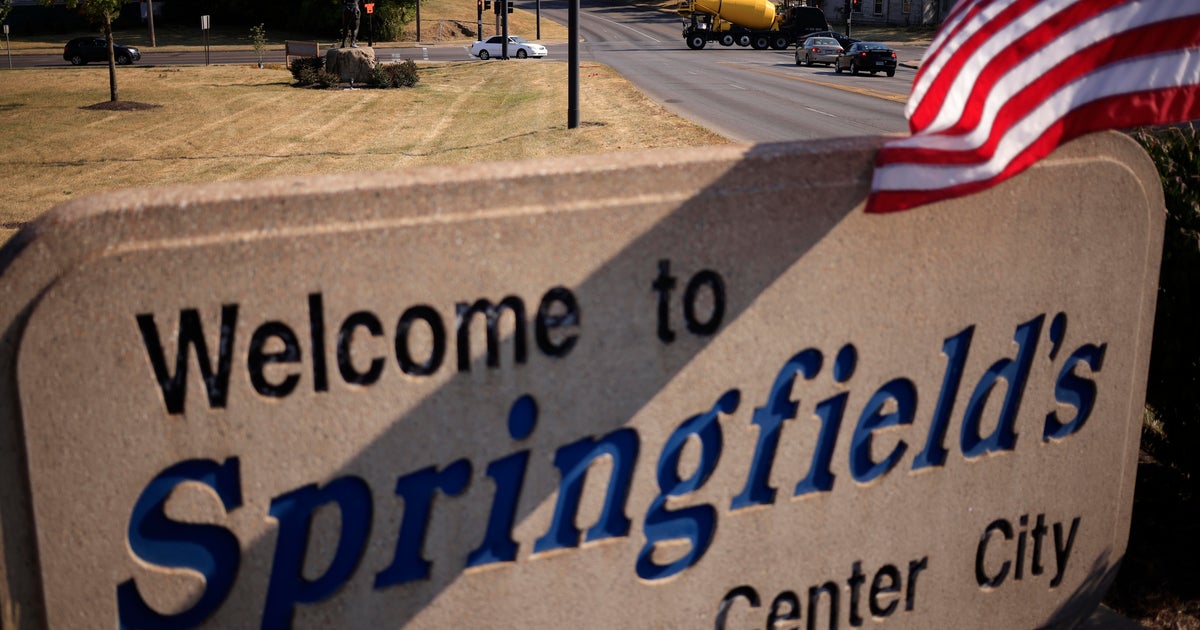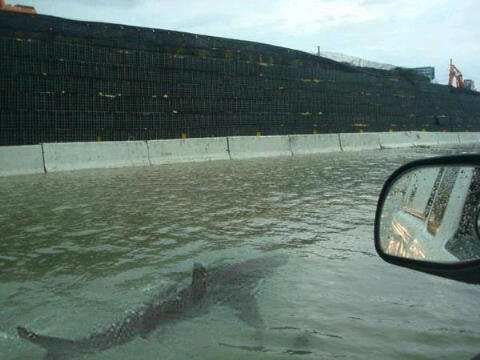CBS News
Amid false claims about Haitian immigrants in Springfield, Ohio, officials say these are the real health challenges

When Ohio senator and Republican vice presidential candidate JD Vance claimed Haitian immigrants had caused infectious-disease rates to “skyrocket” in Springfield, local health commissioner Chris Cook checked the records.
They showed that in 2023, for example, there were four active tuberculosis cases in Ohio’s Clark County, which includes Springfield, up from three in 2022. HIV cases had risen, but sexually transmitted illnesses overall were decreasing.
“I wouldn’t call it skyrocketing,” said Cook, noting that there were 190 active cases in 2023 in all of Ohio. “You hear the rhetoric. But as a whole, reportable infectious diseases to the health department are decreasing.”
Tensions are running high in Springfield, an industrial town of about 58,000 people. Bomb threats closed schools and public buildings after GOP presidential nominee Donald Trump falsely claimed that Haitian immigrants — who he alleged were there illegally — were stealing and eating household pets. City and county officials disputed the claims the former president levied during his Sept. 10 debate with Vice President Kamala Harris, his Democratic opponent.
Trump was amplifying comments made by Vance that — along with his claims about the immigration status of this population — were broadly panned as false. When asked during a CNN interview about the debunked pet-eating rumor, Vance acknowledged that the image he created was based not on facts but on “firsthand accounts from my constituents.” He said he was willing “to create” stories to focus attention on how immigration can overrun communities.
But Ohio Gov. Mike DeWine, also a Republican, has said immigrants have been an economic boon to Springfield. Many began arriving because businesses in the town, which had seen its population decrease, needed labor.
Largely lost in the political rancor is the way Springfield and the surrounding area responded to the influx of Haitian immigrants. Local health institutions tried to address the needs of this new population, which had lacked basic public health care such as immunization and often didn’t understand the U.S. health system.
The town is a microcosm of how immigration is reshaping communities throughout the United States. In the Springfield area, Catholic charities, other philanthropies, volunteers and county agencies have banded together over the past three to four years to tackle the challenge and connect immigrants who have critical health needs with providers and care.
For instance, a community health center added Haitian Creole interpreters. The county health department opened a refugee health testing clinic to provide immunizations and basic health screenings, operating on such a shoestring budget that it’s open only two days a week.
And a coalition of groups to aid the Haitian community was created about two years ago to identify and respond to immigrant community needs. The group meets once a month with about 55 or 60 participants. On Sept. 18, about a week after Trump ramped up the furor at the debate, a record 138 participants joined in.
“We have all learned the necessity of collaboration,” said Casey Rollins, director of Springfield’s St. Vincent de Paul, a nonprofit Catholic social services organization that has become a lifeline for many of the town’s Haitian immigrants. “There’s a lot of medical need. Many of the people have high blood pressure, or they frequently have diabetes.”
Several factors have led Haitians to leave their Caribbean country for the United States, including a devastating earthquake in 2010, political unrest after the 2021 assassination of Haiti’s president, and ongoing gang violence. Even when health facilities in the country are open, it can be too treacherous for Haitians to travel for treatment.
“The gangs typically leave us alone, but it’s not a guarantee,” said Paul Glover, who helps oversee the St. Vincent’s Center for children with disabilities in Haiti. “We had a 3,000-square-foot clinic. It was destroyed. So was the X-ray machine. People have been putting off health care.”
An estimated 12,000 to 15,000 Haitian immigrants live in Clark County, officials said. About 700,000 Haitian immigrants lived in the United States in 2022, according to U.S. Census data.
Those who have settled in the Springfield area are generally in the country legally under a federal program that lets noncitizens temporarily enter and stay in the United States under certain circumstances, such as for urgent humanitarian reasons, according to city officials.
The influx of immigrants created a learning curve for hospitals and primary care providers in Springfield, as well as for the newcomers themselves. In Haiti, people often go directly to a hospital to receive care for all sorts of maladies, and county officials and advocacy groups said many of the immigrants were unfamiliar with the U.S. system of seeing primary care doctors first or making appointments for treatment.
Many sought care at Rocking Horse Community Health Center, a nonprofit, federally qualified health center that provides mental health, primary and preventive care to people regardless of their insurance status or ability to pay. Federally qualified health centers serve medically underserved areas and populations.
The center treated 410 patients from Haiti in 2022, up more than 250% from 115 in 2021, according to Nettie Carter-Smith, the center’s director of community relations. Because the patients required interpreters, visits often stretched twice as long.
Rocking Horse hired patient navigators fluent in Haitian Creole, one of the two official languages of Haiti. Its roving purple bus provides on-site health screenings, vaccinations and management of chronic conditions. And this school year, it’s operating a $2 million health clinic at Springfield High.
Many Haitians in Springfield have reported threats since Trump and Vance made their town a focus of the campaign. Community organizations were unable to identify any immigrants willing to be interviewed for this story.
Hospitals have also felt the impact. Mercy Health’s Springfield Regional Medical Center also saw a rapid influx of patients, spokesperson Jennifer Robinson said, with high utilization of emergency, primary care and women’s health services.
This year, hospitals also have seen several readmissions for newborns struggling to thrive as some new mothers have trouble breastfeeding or getting supplemental formula, county officials said. One reason: New Haitian immigrants must wait six to eight weeks to get into a program that provides supplemental food for low-income pregnant, breastfeeding, or non-breastfeeding postpartum women, as well as for children and infants.
At Kettering Health Springfield, Haitian immigrants come to the emergency department for non-emergency care. Nurses are working on two related projects, one focusing on cultural awareness for staff and another exploring ways to improve communication with Haitian immigrants during discharge and in scheduling follow-up appointments.
Many of the immigrants are able to get health insurance. Haitian entrants generally qualify for Medicaid, the state-federal program for the low-income and disabled. For hospitals, that means lower reimbursement rates than with traditional insurance.
During 2023, 60,494 people in Clark County were enrolled in Medicaid, about 25% of whom were Black, according to state data. That’s up from 50,112 in 2017, when 17% of the enrollees were Black. That increase coincides with the rise of the Haitian population.
In September, DeWine pledged $2.5 million to help health centers and the county health department meet the Haitian and broader community’s needs. The Republican governor has pushed back on the recent national focus on the town, saying the spread of false rumors has been hurtful for the community.
Ken Gordon, a spokesperson for the Ohio Department of Health, acknowledged the difficulties Springfield’s health systems have faced and said the department is monitoring to avert potential outbreaks of measles, whooping cough and even polio.
People diagnosed with HIV in the county increased from 142 residents in 2018 to 178 to 2022, according to state health department data. Cook, the Clark County health commissioner, said the data lags by about 1.5 years.
But Cook said, “as a whole, all reportable infections to the health department are not increasing.” Last year, he said, no one died of tuberculosis. “But 42 people died of COVID.”
KFF Health News is a national newsroom that produces in-depth journalism about health issues and is one of the core operating programs at KFF — the independent source for health policy research, polling, and journalism.
CBS News
Beware the “street shark” and other common hurricane rumors and misinformation

As Florida and the Southeast recover from two major hurricanes, conspiracy theories and falsehoods have surged to levels that the head of the Federal Emergency Management Agency says are unprecedented. First responders, local officials and nonprofit organizations in the storm zones have had to dedicate time and resources to debunking false claims.
Officials say these falsehoods have real-world consequences, including preventing victims from evacuating or seeking help, distracting from recovery efforts and making the job of aid workers harder.
And while the scale of misinformation following Helene and Milton took some by surprise, the claims themselves follow a familiar pattern. Similar misinformation has followed other hurricanes and natural disasters, including exaggerated crime reports, fake or misleading visuals and outright scams. Researchers say understanding the misinformation is crucial to mitigating its spread and minimizing its impact.
Here is a look at some of the recurring themes to watch out for:
Unverified crime scares
In the aftermath of Helene, rumors spread online that people were slashing tires of trucks transporting aid to storm victims, a claim that local police said is not true.
Unverified crimes reports have followed storms for decades. After Hurricane Katrina devastated parts of Louisiana in 2005, officials later said claims of looting, murder, and rape, which were repeated by some news media and officials, were either exaggerated or false.
At one point, the Mayor of New Orleans reported multiple murders at the Louisiana Superdome, where thousands sheltered. The National Guard later said there were no homicides at the stadium.
A 2018 report by the Department of Homeland Security found that false claims often spread after disasters because verified information is slow to emerge, fuelling rumor and speculation.
Conspiracies
Jennie King, director of Climate Disinformation Research and Policy at the Institute for Strategic Dialogue, said conspiracies blaming the government for hurricanes have also become routine. Researchers at the institute found this claim and others debunked by FEMA generated more than 160 million views online after Helene.
“If it is producing a visceral emotion, negative or positive, that should cause you to pause for breath,” King said. “Do a little bit of wider reading. And if you do find out that those claims are false or unsubstantiated, don’t give them additional oxygen.”
Fake or misleading photos or videos
Edited or misleading videos and images have become a regular feature of major weather events. As Hurricane Dorian approached Florida in 2019, old images circulated online that pushed false claims of looting.
After Sandy hit New York and New Jersey in 2013, researchers identified over 10,000 unique posts on Twitter, now called X, that contained fake images.
One of these images was the now-famous “street shark” — an edited image of a shark swimming along a highway — which has reappeared during multiple hurricanes since at least 2011.
Fact checkers also regularly debunk images and videos of landmarks and transportation hubs submerged in water, which can mislead the public during natural disasters.
A digitally altered image of planes under flood waters, created by an artist in an effort to warn about the potential impact of climate change, was falsely described as showing the effects of hurricanes in 2017 and 2018.
And after Hurricane Milton hit Florida, AI-generated images appearing to show flooding at Disney World spread online on multiple platforms.
AI tools have made it easier for people to publish misleading or completely fabricated visuals, according to Anupam Joshi, who co-authored a study on misleading visuals after Hurricane Sandy.
“You need to take everything you see online with a very healthy grain of salt,” said Joshi, the director of the University of Maryland, Baltimore County Cybersecurity Institute.
Scams
Scammers often target victims of hurricanes and those wishing to help them. After Hurricane Katrina, scammers impersonated charities including the Red Cross, which was one of the reasons the U.S. Department of Justice established the National Center for Disaster Fraud.
Jun Zhuang, a researcher who studied misinformation online following Hurricanes Harvey and Irma, told CBS News that scammers solicit money from victims through fraudulent links.
“‘Hey, if you register to this link, you will get $200.’ Or the other way around, ‘Hey, please donate through this link,’ but you never know where your money is going to,” said Zhuang.
Historically, bad actors also target storm victims with offers of assistance. After Hurricane Sandy, fake “contractors” claimed that FEMA would reimburse survivors for damage assessments and rapid repairs to their homes. One of these scammers defrauded 30 people of about $1.9 million.
To avoid falling victim to scams, FEMA has advised people to be wary of unsolicited messages and to verify charities before donating.
CBS News
Boeing says it’s cutting 10% of its workforce, or about 17,000 employees

Boeing on Friday said it’s cutting 10% of its workforce, or about 17,000 employees.
In a in a memo Friday, CEO Kelly Ortberg announced the layoffs, writing that the aerospace giant must make “tough decisions” to stay competitive. Ortberg added that the company is also delaying its program to develop the 777X airplane and halting production of the 767 aircraft after it delivers the remaining 767 planes that have been ordered by customers.
The layoffs and production changes come amid a labor dispute at Boeing, with 33,000 machinists going on strike last month after failing to agree on a contract. The aerospace giant’s finances and reputation have also taken a hit this year due to manufacturing problems and multiple federal investigations, following a mid-air panel blowout in January.
“Our business is in a difficult position, and it is hard to overstate the challenges we face together,” said Ortberg in the memo. “Beyond navigating our current environment, restoring our company requires tough decisions and we will have to make structural changes to ensure we can stay competitive and deliver for our customers over the long term.”
Ortberg, the former head of aerospace company Rockwell Collins, joined Boeing as CEO in August, replacing outgoing CEO Dave Calhoun in the wake of increased regulatory scrutiny sparked by production problems at the storied company.
In his Friday memo, Ortberg said the layoffs will include executives, managers and employees, and take place within the “coming months.”
CBS News
Trump campaign requested use of military aircraft for final stage of campaign

Washington — Former President Donald Trump’s campaign requested military assets to enhance his security in the final weeks of the campaign in the wake of threats to his life, two sources familiar with the matter told CBS News.
In emails to the White House and the Secret Service late last week, the Trump campaign requested that a military aircraft be used to transport the former president before the election, according to the sources. The request also included expanded flight restrictions over Trump’s residences and campaign rallies, as well as the use of ballistic glass — a security measure the former president is already receiving.
The Washington Post first reported the requests Friday.
The development follows two assassination attempts against Trump since July. He was also the target of an alleged murder-for-hire plot involving a Pakistani national with ties to Iran. The country holds the former president and his administration officials responsible for a drone strike that killed Iranian Maj. Gen. Qasem Soleimani in 2020.
President Biden seemed receptive to the enhanced campaign security measures on Friday, telling reporters he “told the department to give him every, every single thing he needs.”
“As long as he doesn’t ask for F-15s,” Mr. Biden said at the White House.
He said the Republican presidential nominee should be treated as if “he were a sitting president.”
“If it fits within that category, that’s fine,” he added. “But if it doesn’t, he shouldn’t.”
The enhanced security is a break from precedent. No presidential nominee or former president in recent history has been transported by military plane before an election.
After the second assassination attempt against Trump, Mr. Biden signed a bipartisan bill that bolsters the Secret Service protection for major presidential and vice presidential candidates. The bill requires Secret Service to apply the same standards in determining the number of agents needed to protect the president, vice president and the major candidates for those offices.
In a statement to CBS News, Secret Service spokesperson Anthony Guglielmi said Trump “is receiving the highest levels of protection.”
“Assistance from the Department of Defense is regularly provided for the former President’s protection, to include explosive ordnance disposal, canine units, and airlift transportation,” he said. “Other enhancements the Secret Service has is providing includes Temporary Flight Restrictions (TFRs) over the former President’s residence and when he travels. Additionally, the former President is receiving the highest level of technical security assets which include unmanned aerial vehicles, counter unmanned aerial surveillance systems, ballistics and other advanced technology systems.”
Guglielmi said the Secret Service will “continue to adjust and enhance its protective posture as needed to mitigate evolving threats.”
contributed to this report.








